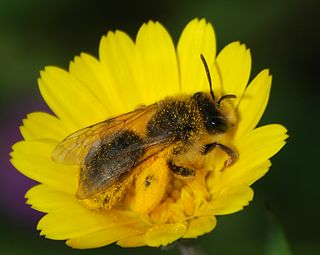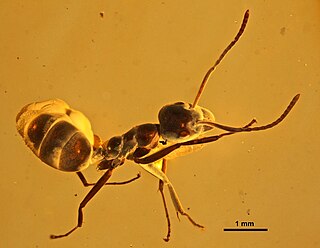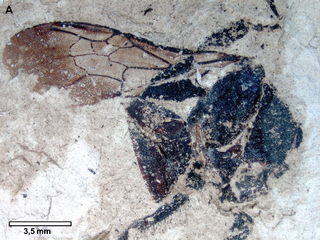
The Andrenidae are a large, nearly cosmopolitan family of solitary, ground-nesting bees. Most of the family's diversity is located in temperate or arid areas. It includes some enormous genera. One of the subfamilies, Oxaeinae, is so different in appearance that they were typically accorded family status, but careful phylogenetic analysis reveals them to be an offshoot within the Andrenidae, very close to the Andreninae.

Andrena is a genus of bees in the family Andrenidae. With over 1,500 species, it is one of the largest genera of animals. It is a strongly monophyletic group that is difficult to split into more manageable divisions; currently, Andrena is organized into 104 subgenera. It is nearly worldwide in distribution, with the notable exceptions of Oceania and South America. Bees in this genus are commonly known as mining bees due to their ground-nesting lifestyle.

Myanmymar is an extinct genus of fairyfly preserved in Burmese amber from Myanmar. It has only one species, Myanmymar aresconoides. It is dated to the earliest part of the Cenomanian stage of the Late Cretaceous, around 99 million years old. As of 2011, it is the oldest known fossil mymarid.
Uintascorpio is an extinct genus of scorpion in the family Buthidae and containing the single species Uintascorpio halandrasorum. The species is known only from the Middle Eocene Parachute Member, part of the Green River Formation, in the Piceance Creek Basin, Garfield County, northwestern Colorado, USA.

Megaphragma is a genus of wasp in the family Trichogrammatidae. It contains some of the smallest known insects, Megaphragma caribea and Megaphragma mymaripenne, which are roughly the same size as some unicellular protozoans.

Emplastus is an extinct morphogenus of ants in the subfamily Dolichoderinae, known from fossils found in Asia and Europe. The genus contains twelve species described from sites in England, Eastern Europe and Far Eastern Russia.

Casaleia is an extinct genus of ants in the formicid subfamily Amblyoponinae described by Pagliano & Scaramozzino in 1990 from fossils found in Europe. The genus contains four species dating from the Eocene to Miocene, Casaleia eocenica, Casaleia inversa, Casaleia longiventris, Casaleia orientalis.

Yantaromyrmex is an extinct genus of ants first described in 2013. Members of this genus are in the subfamily Dolichoderinae of the family Formicidae, known from Middle Eocene to Early Oligocene fossils found in Europe. The genus currently contains five described species, Y. constrictus, Y. geinitzi, Y. intermedius, Y. mayrianum and Y. samlandicus. The first specimens were collected in 1868 and studied by Austrian entomologist Gustav Mayr, who originally placed the fossils in other ant genera until the fossils were reviewed and subsequently placed into their own genus. These ants are small, measuring from 4 to 6 mm in length and can be characterized by their trapezoidal shaped head-capsules and oval compound eyes that are located slightly to the rear of the capsules midpoint, with no known ocelli present.

Bombus cerdanyensis is an extinct species of bumble bee in the family Apidae known from a fossil found in Europe.

Protopone is an extinct genus of ants in the formicid subfamily Ponerinae described from fossils found in Europe and Asia. There are seven described species placed into the genus, Protopone? dubia, Protopone germanica, Protopone magna, Protopone oculata, Protopone primigena, Protopone sepulta, and Protopone vetula. Protopone is one several Lutetian Ponerinae genera.

Tityus apozonalli is an extinct species of scorpion in the family Buthidae known from a fossil found in North America. The species is one of two scorpions described from Mexican amber and one of seven species from Central American amber deposits.

Cyrtopone is an extinct genus of ants in the formicid subfamily Ponerinae described from fossils found in Europe. There are four described species placed into the genus, Cyrtopone curiosa, Cyrtopone elongata, Cyrtopone microcephala, and Cyrtopone striata. Cyrtopone is one several Lutetian Ponerinae genera.

Euglossopteryx is an extinct genus of bee in the family Apidae known from a fossil found in North America. There is one described species in the genus, Euglossopteryx biesmeijeri.

Protohabropoda is an extinct genus of bees in the family Apidae known from a fossil found in Europe. The genus currently contains a single described species Protohabropoda pauli.

Gyaclavator is an extinct genus of lace bug in the family Tingidae known from a fossil found in North America. The genus contains a single species, Gyaclavator kohlsi.

Gerontoformica is an extinct genus of stem-group ants. The genus contains thirteen described species known from Late Cretaceous fossils found in Asia and Europe. The species were described between 2004 and 2016, with a number of the species formerly being placed into the junior synonym genus Sphecomyrmodes.

Bradoponera is an extinct genus of ant in the Formicidae subfamily Proceratiinae, and is one of four genera of the subfamily. The genus contains four described species Bradoponera electrina, Bradoponera meieri, Bradoponera similis, and Bradoponera wunderlichi. The species are known from several Middle Eocene amber fossils which were found in Europe.

Bombus trophonius is an extinct species of bumble bee known from a Miocene fossil found in Europe. It belongs to the Bombus subgenus Cullumanobombus and is considered most similar to the living species Bombus rufocinctus of North America.

Andrena lagopus is a species of mining bees belonging to the family of Andrenidae.
Andrena ghisbaini, Ghisbain's mining bee, is a species of solitary bee from the family Andrenidae. It was described in 2023 based on specimens collected in southern Spain.

















